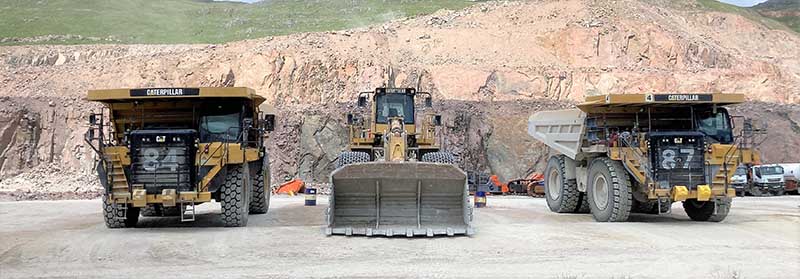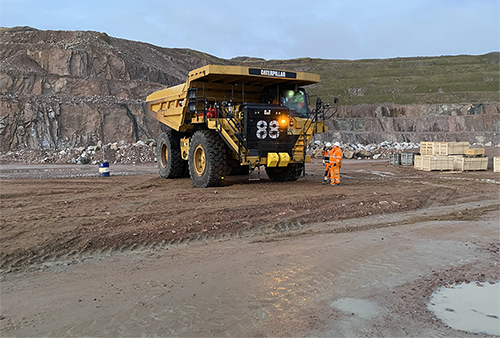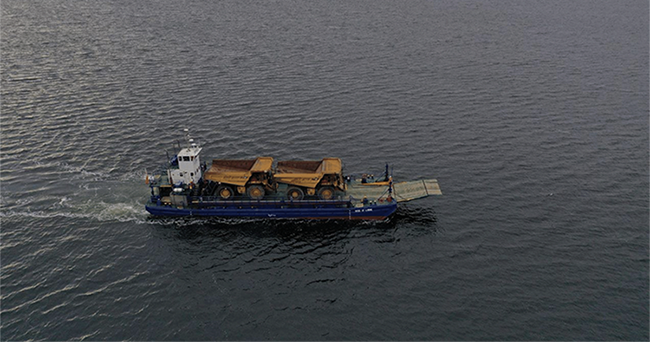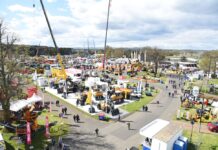FINNING has provided details of its landmark project to supply a fleet of Cat machines to help building materials supplier Aggregate Industries bring operations at Europe’s largest granite quarry in-house.
Located off the Western Coast of Scotland, Glensanda Quarry is a unique site where any machinery being delivered must first navigate the Highland roads complete with police escort before finally reaching the site via barge.
Finning prepared and managed the delivery of 18 machines, as well as providing full operator training on site ready for a go-live date on January 3rd, 2023.
Discussions between Aggregate Industries and the Finning team began over the summer of 2022. Finning conducted a detailed site production analysis to assess the scope of equipment required to ensure they maintained the levels of production on the site. Once the scope was agreed, the firm sourced the machinery from its portfolio of used equipment.
Mick Leonard, strategic account manager at Finning UK & Ireland, explained, “We’ve had a long relationship with Aggregate Industries having supplied them with new equipment many times over the years. However, the solution we recommended to meet their short time frame and to ensure production could continue without any interruption, involved purchasing used equipment.
“This not only enabled them to maximise their financial investment – using a solution provided by Cat Financial alongside Capex, but also ensured they were able to meet their mobilisation deadline and supported their sustainability ambitions with used machines using less energy through manufacturing than new.
“Through our network within the UK and Europe we sourced a fleet of three Cat 992 large wheel loaders, 12 Cat 777 off-highway trucks, a Cat D9 dozer, a Cat 16-motor grader and a Cat 966 medium wheel loader. All the equipment was then transported to the Finning workshop in Glasgow to have any component repairs carried out, before being fully prepped and all the necessary safety features added so they could operate on site.
“Having sourced the equipment, we next needed to overcome the logistical challenge of getting them to the site – which is only accessible via the sea. All the equipment was first transported by truck to Oban, before being loaded onto barges and taken to site. Once delivered, we then arranged for our internal equipment operating training team to go to site, to facilitate training for more than 30 of Aggregate Industries’ operators.
“With the right operator skills, the used equipment offered significant fuel savings when compared to their ageing fleet. The deal also included a five-year service agreement, with parts delivery planned on site to coincide with service schedules and plans for delivery of an on-site hose solution would further ensure machine uptime.”
Calum Carnie, works manager at Glensanda Quarry, added, “A changing and challenging set of circumstances led to a very demanding timescale and delivery schedule for Finning and Aggregate Industries to ensure the Super Quarry was able to continue producing uninterrupted. Working toward this shared objective, the management teams of both companies worked closely to plan and coordinate everything from repair work, tyre fitting, road movement orders, barge bookings and sailings right through to machine assembly, commissioning and operator training.
“While the capability of Cat equipment is well known, the condition and reality of a used fleet is not, so the Finning team worked hard to make sure inspections were carried out, available machine history was shared and an overhaul and component replacement programme was understood for both pre and post delivery.
“One year in and the team continues to work well together to make sure we achieve high availability, productivity and the best possible cost per tonne from our assets.”
With more than 54 quarries around the UK, being able to access Cat Finance to fund the fleet without compromising other operations was described as ‘key’ for the Aggregate Industries team, while choosing a used fleet means they have ‘maximum flexibility’ to take advantage of new machine technologies going forward as they update their equipment.















